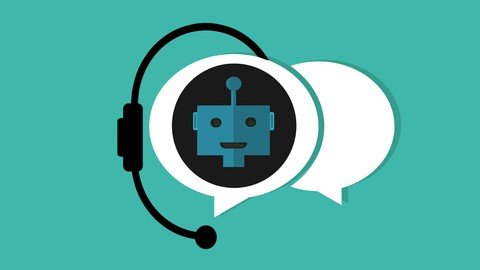
Published 1/2023
MP4 | Video: h264, 1280×720 | Audio: AAC, 44.1 KHz
Language: English | Size: 1.04 GB | Duration: 2h 39m
Build an AI Chatbot using the concepts of Natural Language Processing
What you’ll learn
Fundamentals of chatbot design
Understanding the concepts of NLP
Implementation of Rule based chatbot
Implementation of NLP based self learning bot
Requirements
No, but a little knowledge in Python would help
Description
Welcome! Anyone interested in learning how to build their own chatbots using natural language processing (NLP) methods should take this course. The fundamentals of NLP and how chatbot creation uses it will be covered.You will acquire practical experience during the course creating your own chatbot using well-known NLP libraries and frameworks like NLTK. You’ll discover how to use intents, entities, and action to train your model.Additionally, you will discover the various varieties of chatbots, including rule-based, retrieval-based, and generative ones. You will also discover how chatbots are evaluated.A chatbot is a computer program designed to simulate conversation with human users, especially over the Internet. They can be integrated into various platforms such as websites, mobile apps, messaging apps, and more. They are commonly used for customer service, providing information, or automating repetitive tasks.Natural Language Processing (NLP) is a subfield of artificial intelligence that focuses on the interaction between computers and humans in natural language. It involves using techniques from computer science, artificial intelligence, and linguistics to process, analyze, and generate human language. NLP tasks include speech recognition, natural language understanding, sentiment analysis, text summarization, machine translation, and more. NLP techniques are used in many applications such as chatbots, virtual assistants, and language translation software.These are the contents of this courseFundamentals of ChatbotsTypes of chatbots – Rule based, AI basedFundamentals of NLPNLP Techniques – Stemming, Lemmatization, Bag of Words, TF-IDF, Cosine SimilarityRule based chatbots – ImplementationNLP Wordnet – ImplementationNLP Incorporated chatbots – ImplementationDynamic Web Surfing Chatbots – ImplementationProjects:1. Building a rule based chatbot2. Building an NLP based chatbot3. Building a dynamic web surfing chatbot
Overview
Section 1: Introduction
Lecture 1 Introduction
Lecture 2 2. Basics of Chatbots and conversation
Section 2: Concepts, Types and Modes of Chatbots
Lecture 3 Info
Lecture 4 3. Types of chatbots
Lecture 5 4.Rule Based chatbots
Lecture 6 5. Implementation – Rule Based chatbots
Lecture 7 6. NLP Based chatbots
Lecture 8 7. Different modes of chatbots
Section 3: Concepts of Natural Language Processing and its Toolkit
Lecture 9 8. Introduction to Natural Language Processing
Lecture 10 9. Breaking down NLP Terms
Lecture 11 10. Introduction to nltk
Lecture 12 11. Working with nltk wordnet
Lecture 13 12.Applications of Natural Language Processing
Section 4: Steps in developing a NLP based Chatbot
Lecture 14 13. Steps in building a NLP Chatbot
Lecture 15 14. Data Preprocessing steps in NLP – I
Lecture 16 15. Stemming and Lemmatization – II
Lecture 17 16. The TF-IDF Vectorizer
Lecture 18 17. Solving TF-IDF for an example
Lecture 19 18. The Cosine Similarity
Section 5: Project – Implementation of an NLP based Chatbot
Lecture 20 19. Implementation – Tokenization
Lecture 21 20. Implementation – Lemmatization
Lecture 22 21. Implementation – Greeting
Lecture 23 22. Implementation – Generating response
Lecture 24 23. Bot in Action!
Section 6: Dynamic API + NLP Bots!
Lecture 25 24. Dynamic web surfing bot
Lecture 26 Bonus Lecture
Anyone who wants to build his/her own chatbot
Password/解压密码www.tbtos.com